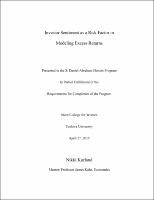Please use this identifier to cite or link to this item:
https://hdl.handle.net/20.500.12202/4183Full metadata record
| DC Field | Value | Language |
|---|---|---|
| dc.contributor.author | Kurland, Nikki | - |
| dc.date.accessioned | 2018-11-08T21:15:23Z | - |
| dc.date.available | 2018-11-08T21:15:23Z | - |
| dc.date.issued | 2015-04 | - |
| dc.identifier.uri | https://hdl.handle.net/20.500.12202/4183 | - |
| dc.identifier.uri | https://ezproxy.yu.edu/login?url=https://repository.yu.edu/handle/20.500.12202/4183 | |
| dc.description | The file is restricted for YU community access only. | - |
| dc.description.abstract | One fundamental issue that concerns market participants and theorists alike is whether or not it is possible to systematically “beat the market” and produce persistent, risk-adjusted excess returns. In addressing this issue, theorists largely fall into two camps. The former are proponents of the Efficient Market Hypothesis, which at its core argues that the persistence of risk-free excess returns is impossible. On the other hand, behavioral theorists argue that the market has an irrational component that makes room for persistent mispricing, and exploitation of these inefficiencies can allow superior investors to capture risk-adjusted excess returns. Recent studies have provided evidence that investor sentiment is an important factor in the analysis of market activity. Behaviorists use this as evidence of market irrationality, and attempt to uncover methods of exploiting sentiment data to earn risk-adjusted excess returns. EMH theorists, on the other hand, defend efficiency by arguing that sentiment does not influence valuations in the long run, or by explaining that sentiment can only play a role when efficiency assumptions are not met. Regardless of which camp is “correct,” modern portfolio theory does not currently have a role for investor sentiment; assuming sentiment is significant, omitting it as a factor in financial modeling can lead to major errors in the calculation of portfolio values, risks, and expected returns. This study aims to augment past research and current valuation models by incorporating investor sentiment as a risk factor and examining its implications on asset pricing. | en_US |
| dc.description.sponsorship | S. Daniel Abraham Honors Program | en_US |
| dc.language.iso | en_US | en_US |
| dc.publisher | Stern College for Women | en_US |
| dc.rights | Attribution-NonCommercial-NoDerivs 3.0 United States | * |
| dc.rights.uri | http://creativecommons.org/licenses/by-nc-nd/3.0/us/ | * |
| dc.subject | Efficient market theory. | en_US |
| dc.subject | Economic forecasting. | en_US |
| dc.subject | Stocks --Prices. | en_US |
| dc.subject | Risk. | en_US |
| dc.subject | Stocks --Rate of return. | en_US |
| dc.title | Investor Sentiment as a Risk Factor in Modeling Excess Returns | en_US |
| dc.type | Thesis | en_US |
| Appears in Collections: | S. Daniel Abraham Honors Student Theses | |
Files in This Item:
| File | Description | Size | Format | |
|---|---|---|---|---|
| Nikki-Kurland.pdf Restricted Access | 619.28 kB | Adobe PDF |  View/Open |
This item is licensed under a Creative Commons License

